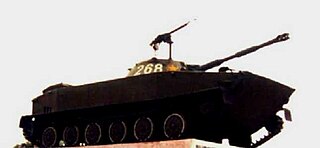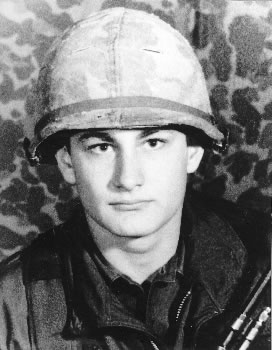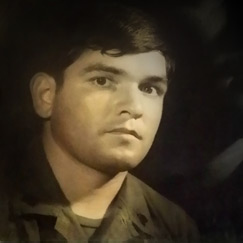
The Battle of Lang Vei began on the evening of 6 February 1968 and concluded during the early hours of 7 February, in Quảng Trị Province, South Vietnam. Towards the end of 1967, the 198th Tank Battalion of the People's Army of Vietnam's (PAVN) 202nd Armored Regiment received instructions from the North Vietnamese Ministry of Defense to reinforce the 304th Division as part of the Route 9–Khe Sanh Campaign. After an arduous journey down the Ho Chi Minh trail in January 1968, the 198th Tank Battalion linked up with the 304th Division for an offensive along Highway 9, which stretched from the Laotian border through to Quảng Trị Province. On 23 January, the 24th Regiment attacked the small Laotian outpost at Bane Houei Sane, under the control of the Royal Laos Army BV-33 "Elephant" Battalion. In that battle, the 198th Tank Battalion failed to reach the battle on time because its crews struggled to navigate their tanks through the rough local terrain. However, as soon as the PT-76 tanks of the 198th Tank Battalion turned up at Bane Houei Sane, the Laotian soldiers and their families retreated into South Vietnam.

John Philip Baca is a former United States Army soldier and a Vietnam War veteran. He was awarded the Medal of Honor, the highest decoration of the United States Armed Forces, for his actions in Vietnam.

Daniel D. Fernández was a United States Army soldier in the Vietnam War who received the U.S. military's highest decoration, the Medal of Honor, for his actions in Hậu Nghĩa province, Republic of Vietnam, in February 1966 — throwing himself on a live grenade, he sacrificed his life to save lives of the soldiers around him.

Garfield McConnell Langhorn was a United States Army soldier and a recipient of America's highest military decoration—the Medal of Honor—for his actions in the Vietnam War.

Mitchell William Stout was a United States Army soldier and a recipient of the United States military's highest decoration—the Medal of Honor—for his actions in the Vietnam War.

Robert Martin Patterson is a retired United States Army soldier and a recipient of the United States military's highest decoration, the Medal of Honor, for his actions in the Vietnam War.

Ray McKibben was a United States Army soldier and a recipient of the United States military's highest decoration—the Medal of Honor—for his actions in the Vietnam War.

Thomas James Kinsman was a United States Army soldier and a recipient of the United States military's highest decoration—the Medal of Honor—for his actions in the Vietnam War.

Kenneth Michael Kays was a United States Army soldier and a recipient of the United States military's highest decoration—the Medal of Honor—for his actions in the Vietnam War.

Donald Ray Johnston was a United States Army soldier and a recipient of the United States military's highest decoration—the Medal of Honor—for his actions in the Vietnam War.

Frank Aloysious Herda was a United States Army soldier and a recipient of the United States military's highest decoration, the Medal of Honor, for his actions in the Vietnam War.

Peter Matthew Guenette was a United States Army soldier and a recipient of the United States military's highest decoration—the Medal of Honor—for his actions in the Vietnam War.

Michael Fleming Folland was a United States Army soldier and a recipient of the United States military's highest decoration—the Medal of Honor—for his actions in the Vietnam War.

Edward Allen DeVore Jr. was a United States Army soldier and a recipient of the United States military's highest decoration—the Medal of Honor—for his actions in the Vietnam War.

Larry Gilbert Dahl was a United States Army soldier and a recipient of the United States military's highest decoration—the Medal of Honor—for his actions in the Vietnam War.

Nicholas Joseph Cutinha was a United States Army soldier and a recipient of the United States military's highest decoration—the Medal of Honor—for his actions in the Vietnam War.

Michael Reinert Blanchfield was a United States Army soldier and a recipient of the United States military's highest decoration—the Medal of Honor—for his actions in the Vietnam War.

Candelario Garcia, Jr. was a United States Army veteran of the Vietnam War, and a recipient of the Medal of Honor.
Firebase Illingworth is a former U.S. Army firebase northwest of Tây Ninh in southwest Vietnam.















